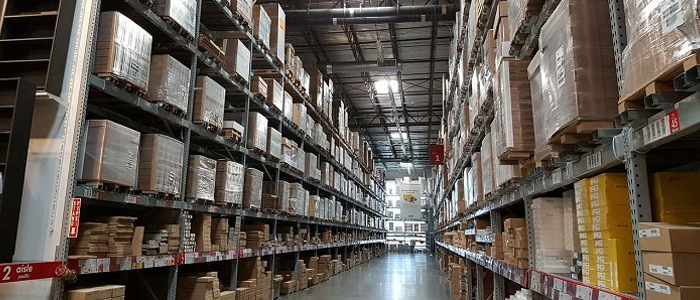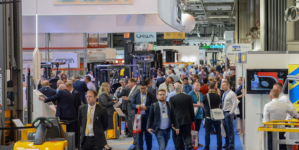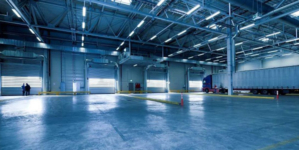-
ROSSLARE EUROPORT TARGETS HEALTH & SAFETY WITH CAMERA TELEMATICS PARTNERSHIP - 2 days ago
-
Landmark Study Reveals Wearable Robotics Significantly Boost Safety and Efficiency in Industrial Environments - July 24, 2024
-
Visku Tackle The Retail Seasonality Challenge One Pallet At A Time - July 22, 2024
-
KAMMAC AND BERGEN LOGISTICS STRENGTHEN FASHION & LIFESTYLE SERVICES IN THE UK - July 19, 2024
-
TENTBOX EXTENDS PARTNERSHIP WITH ARROWXL TO SUPPORT INCREASING DEMAND - July 17, 2024
-
The Perfume Shop improves customer journeys while driving profitability in partnership with Scurri - July 17, 2024
-
ZEROMISSION SECURES £2.3M ($3M) INVESTMENT TO ACCELERATE ELECTRIC FLEETS - July 16, 2024
-
BCMPA CELEBRATES SUCCESS OF 2024 CONFERENCE - July 15, 2024
-
Best of the Best: Jungheinrich Celebrates Triple International Award Win - July 12, 2024
-
GOPLASTICPALLETS.COM CALLS ON NEW CHANCELLOR RACHEL REEVES TO CONSIDER PLASTIC PACKAGING TAX REFORM - July 10, 2024
What is warehouse automation (and do I need it)?
Ask the average person to describe the storage industry, and they’d probably conjure up images of the Terminator. With Amazon and Ocado making headlines for their robot-driven warehouses, the public perception is increasingly that robots have already taken many warehouse jobs, and will soon be coming for the rest.
While the reality is more mundane, that future may not be too far off. Automation is making their way into more businesses, and warehouses are certainly a prime candidate. But while the giants of the industry continue to experiment with robotics, many people further down the chain still don’t really understand automation, or question its value to them. So what is warehouse automation exactly, and do you need to worry about it yet?
Warehouse automation explained
In a sense, warehouse automation is exactly what it sounds like. The aim is to automate repetitive, laborious, dangerous or time-consuming tasks in the warehouse space, alleviating the issues that commonly arise from these processes. By using robots or other autonomous vehicles, a business can eliminate the factor of human error almost entirely.
This not only has the potential to dramatically reduce errors – and therefore damages, injuries and inefficiencies – but also frees workers up for other tasks. The common misconception around automation is that it inevitably means human jobs are replaced with robots. While this is inevitably true in some cases, the goal of automation should be to alleviate the physical and mental burden caused by difficult or repetitive tasks, and free up workers for value-added roles.
While automation is most often applied to robots and autonomous vehicles, it can also refer to any process which is automated. This could include the use of a warehouse management system (WMS) or other software to automate aspects of the supply chain, such as real-time inventory management, HVAC and lighting control, or even safety protocols and inspections.
What kinds of tasks can be automated?
The scope of warehouse automation is increasing all the time as robots become more advanced. However, the most cutting-edge robots are extremely specific in their applications, such as the Ocado robots which zip across the top of a racking system in a custom-designed, multi-million pound facility. As such, the applications of robots in most warehouses have remained consistent over the last couple of years.
In short, any task which is simple, repetitive or strenuous is an ideal target for warehouse automation. While tasks which require substantial manual dexterity – such as picking fragile or delicate goods – are currently beyond the capabilities of most robots, automation has the capacity to revolutionise most elements of the storage and distribution chain. Examples include:
- Picking and sorting
- Labelling and scanning
- Loading and unloading
- Inventory management
- Back-office processes
- Data analysis & trends
What are the different kinds of warehouse automation?
While automation can be classified as simply as ‘robots’ and ‘software’, it tends to be subdivided further into its specific applications within the storage sector. Here are a few of the terms and acronyms you’re likely to see when you’re reading about warehouse automation.
1. Goods-to-person technologies (GTP)
Much as it sounds, goods-to-person describes an autonomous system which locates items and brings them to the picking area. In conjunction with a WMS, a GTP system can receive an order via wireless communication, travel to the aisle where it’s located, fetch the pallet or item and bring it to the correct location where it can be prepared for shipping or use.
A GTP system may be comprised of half a dozen or more different elements, including shuttles, trolleys, conveyors and autonomous robots. GTP systems are often built from the ground-up to automate and interlink the whole fulfilment process, with human operatives interacting with each element in the chain. This unified system of automated processes is a major change to your operations, but has the potential to dramatically increase throughput and dispatch times.
2. Automated storage and retrieval systems (AS/RS)
While AS/RS is technically a type of GTP technology, it’s often classified as a distinct form of automation. Often installed in conjunction with high-density, single purpose racking systems, AS/RS uses shuttles on purpose-built rails to quickly navigate the face of the racking system, and commute pallets or items to personnel.
AS/RS is often used for the retrieval of small, uniform items in a high density system, such as film or document archives. Operating on rails allows AS/RS to quickly move both horizontally and vertically, improving throughput. However, it’s movement tends to be limited to the face of the racking, and requires intermediaries to transport the goods to the picking or distribution area.
3. Autonomous mobile robots (AMRs)
Autonomous mobile robots are the latest innovation in warehouse automation, and what most people think of when they imagine warehouse robots. These robots feature complex arrays of sensors, which allow them to commute around a warehouse without bumping into people or objects. At present, AMRs are usually only involved with one part of the fulfilment or storage process, though interoperability between different robots is improving.
Usage scenarios for AMRs include:
- Locating and transporting full cartons or totes
- Loading and unloading pallets
- Sorting items
- Picking to cartons or totes
- Cleaning or marking spillages
4. Pick-to-light systems
Pick-to-light (sometimes known as pick-by-light) systems are an older implementation of autonomous technology, designed primarily for zone picking. Instead of using robots or automated vehicles, pick-to-light enhances the picking process with a simple system of lights, helping to expedite the order fulfilment process. While these systems require modifications to your racking, they are low maintenance and can substantially improve throughput and accuracy.
A worker begins the process by scanning the barcode for an order, which then sends the order details to LED displays local to each worker. Lights direct the operator to the correct location for the items, with the display showing how many of that item needs to be picked. The operator then retrieves the items, sends them for processing and confirms that those items have been retrieved. The next order is then scanned and the process repeats.
Should I implement warehouse automation?
As with any substantive change to your warehouse operations, much will depend on circumstances. If you have recently upgraded your racking or aspects of the supply chain, the improvements delivered by automation may not be dramatic, and you may not wish to jeopardise the improvements you’ve already seen. However, the right systems can be deployed in parallel with your existing operations, and further enhance the fulfilment process.
One of the factors driving the current popularity of warehouse automation is the relative weakness of the labour market, and the common issue of staff turnover. Roles are often difficult to fill, and the expense of training is often wasted when those employees leave after a relatively short period. Automation reduces this sunk cost, on top of the usual benefits of increased productivity – yielding an ROI of six to 18 months on average.
Automation will always be an economic decision first and foremost, and in this sense your decision is entirely reliant on your business, the automation provider you work with, and the area you wish to automate. It’s worth reaching out and obtaining quotes for the work where possible, building a relationship that could bear fruit in the future.
One rapidly developing area of automation is the idea of ‘robots as a service’ (RaaS), where robots are leased to businesses in the same way as other vehicles. This would make both the pricing and adoption more flexible, allowing businesses to road test automation at a price that suits them. The rollout of 5G internet is another factor which could allow for even greater autonomy, and promises to revolutionise all aspects of business.
Fundamentally then, automation offers a number of tangible benefits to businesses today, particularly those with a large supply chain that could stand to be made more efficient. For businesses with smaller operations and storage spaces, it may not be worth switching over just yet – but the rapid development of robotics means it’s an area to keep a close eye on.
James Beale is the Operations Manager at Invicta Pallet Racking. For over 35 years Invicta has been at the forefront of the archive storage industry throughout the UK and Europe, designing and installing some of the largest warehouse racking systems currently found on the market.

































